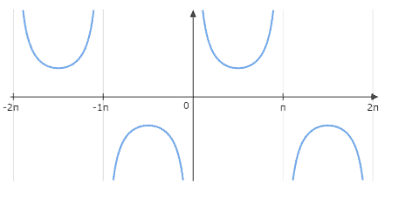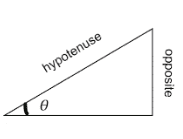
How do you graph $y = - \csc x$
Answer
541.2k+ views
Hint: Graphing the negative of a function essentially implies flipping the function about the X-axis. This question can be approached similarly. We can start by drawing the graph of $y = \csc x$ and then try flipping it around the X-axis.
Complete Step by Step Solution:
We should start solving the question by drawing the graph of $y = \csc x$.
The graph of $y = \csc x$ is as follows:

The range of the x-axis is set from $- 2\pi$ to $2\pi$. An asymptote of a curve can be described as a line such that the distance between the curve and line approaches zero when either one or both of the x and y coordinates tend to infinity.
The graph of $y = \csc x$ has asymptotes at the point $n\pi$ . n is an integer.
When $x = \dfrac{\pi }{2} \pm 2n\pi$ , then the value of $y = 1$
When $x = \dfrac{{3\pi }}{2} \pm 2n\pi$ , then the value of $y = - 1$
The negative sign is used in order to change the sign of the y values. Thus, the positive values of y become negative and the negative values of y become positive. In this case, we’re essentially flipping the equation around the X-axis.
Thus, the graph of $y = - \csc x$ can be drawn as follows:
Note:

The cosecant of any angle, $\theta$ in a right-angled triangle is defined as:
$\csc \theta = \dfrac{{length\left( {hypotenuse} \right)}}{{length(opposite)}}$
Cosecant of an angle can be related to the sine of the angle in the following manner:
$\csc \theta = \dfrac{1}{{\sin \theta }}$
Complete Step by Step Solution:
We should start solving the question by drawing the graph of $y = \csc x$.
The graph of $y = \csc x$ is as follows:

The range of the x-axis is set from $- 2\pi$ to $2\pi$. An asymptote of a curve can be described as a line such that the distance between the curve and line approaches zero when either one or both of the x and y coordinates tend to infinity.
The graph of $y = \csc x$ has asymptotes at the point $n\pi$ . n is an integer.
When $x = \dfrac{\pi }{2} \pm 2n\pi$ , then the value of $y = 1$
When $x = \dfrac{{3\pi }}{2} \pm 2n\pi$ , then the value of $y = - 1$
The negative sign is used in order to change the sign of the y values. Thus, the positive values of y become negative and the negative values of y become positive. In this case, we’re essentially flipping the equation around the X-axis.
Thus, the graph of $y = - \csc x$ can be drawn as follows:
Note:

The cosecant of any angle, $\theta$ in a right-angled triangle is defined as:
$\csc \theta = \dfrac{{length\left( {hypotenuse} \right)}}{{length(opposite)}}$
Cosecant of an angle can be related to the sine of the angle in the following manner:
$\csc \theta = \dfrac{1}{{\sin \theta }}$
Recently Updated Pages
Master Class 11 Business Studies: Engaging Questions & Answers for Success

Master Class 11 Computer Science: Engaging Questions & Answers for Success

Master Class 11 Maths: Engaging Questions & Answers for Success

Master Class 11 Chemistry: Engaging Questions & Answers for Success

Master Class 11 Economics: Engaging Questions & Answers for Success

Master Class 11 Accountancy: Engaging Questions & Answers for Success

Trending doubts
What is meant by exothermic and endothermic reactions class 11 chemistry CBSE

10 examples of friction in our daily life

One Metric ton is equal to kg A 10000 B 1000 C 100 class 11 physics CBSE

1 Quintal is equal to a 110 kg b 10 kg c 100kg d 1000 class 11 physics CBSE

Difference Between Prokaryotic Cells and Eukaryotic Cells

What are Quantum numbers Explain the quantum number class 11 chemistry CBSE




